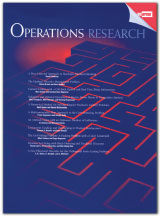Academic articles
Practitioner articles
Working papers
Books
Book chapters
Case studies
Other publications
Subject(s)
Diversity and inclusion; Health and environment; Management sciences, decision sciences and quantitative methods; Product and operations management
Keyword(s)
shared medical appointments, patient compliance, patient satisfaction, innovation in healthcare delivery, global public health, healthcare operations
In Shared Medical Appointments (SMAs), patients with similar conditions meet the physician together and each receives one-on-one attention. SMAs can improve outcomes and physician productivity. Yet privacy concerns have stymied adoption. In physician-deprived nations, patients’ utility from improved access may outweigh their disutility from loss of privacy. Ours is to our knowledge the first SMA trial for any disease, in India, where doctors are scarce. In a 1,000-patient, single-site, randomized controlled trial at Aravind Eye Hospital, Pondicherry, we compared SMAs and one-on-one appointments, over four successive visits, for patients with glaucoma. We examined patients’ satisfaction, knowledge, intention-to-follow-up, follow-up rates, and medication compliance rates (primary outcomes) using intention-to-treat analysis. Of 1,034 patients invited between July 12, 2016 – July 19, 2018, 1,000 (96.7%) consented to participate, and were randomly assigned to either SMAs (NSMA=500) or one-on-one appointments (N1-1=500). Patients who received SMAs showed higher satisfaction (MeanSMA=4.955 (SD 0.241), Mean1-1=4.920 (SD 0.326); difference in means 0.035; 95% CI, 0.017-0.054, p=0.0002) and knowledge (MeanSMA=3.416 (SD 1.340), Mean1-1=3.267 (SD 1.492); difference in means 0.149; 95% CI, 0.057–0.241, p=0.002) than patients who received one-on-one appointments. Across conditions, there was no difference in patients’ intention-to-follow-up (MeanSMA=4.989 (SD 0.118), Mean1-1=4.986 (SD 0.149); difference in means 0.003; 95% CI, -0.006–0.012, p=0.481) and actual follow-up rates (MeanSMA=87.5% (SD 0.372), Mean1-1=88.7% (SD 0.338); difference in means -0.012; 95% CI, -0.039–0.015, p=0.377). Patients who received SMAs exhibited higher medication compliance rates (MeanSMA=97.0% (SD 0.180), Mean1-1=94.9% (SD 0.238); difference in means 0.020; 95% CI, 0.004–0.036, p=0.013). SMAs improved satisfaction, learning, and medication compliance, without compromising follow-up rates or measured clinical outcomes. Peer interruptions were negatively correlated with patient satisfaction in early-trial SMAs and positively correlated with patient satisfaction in later-trial SMAs. The trial was registered with Clinical Trials Registry of India with reference no. REF/2016/11/012659 and registration no. CTRI/2018/02/011998.
©2023 Sönmez et al.
Volume
3
Journal Pages
e0001648
ISSN (Online)
2767-3375
Subject(s)
Marketing
Keyword(s)
price negotiation, power, dependency, buyer–seller relationship, demand contraction
Extant literature has studied how customer–salesperson price negotiations evolve in “normal” circumstances. However, recent economic recessions illustrate the need to advance theory on the question of how price negotiations evolve in “abnormal” times when customer demand significantly contracts beyond expected variation. In response to this gap in the literature, this study uses a multi-method design to investigate price negotiations during exceptional demand contractions. Our results from a theories-in-use study reveal that during such circumstances, salespeople’s perceived dependency on customers increases while customers’ perceived dependency on salespeople decreases. The inherent “power shift” should benefit customers in subsequent price negotiations. However, customers are less likely to capitalize on their power if they have a close relationship with a salesperson, implying that salespeople do not have to concede on price negotiations. This effect is likely due to increased sympathy during periods of exceptional demand contractions. The authors further validate key propositions from this qualitative study in a field study and a scenario-based experiment. Altogether, this study suggests that managers should not be too hasty in approving and encouraging salespeople to offer unnecessary price discounts during exceptional demand contractions as buyers may become more sympathetic and lenient during price negotiations.
With permission of SAGE Publishing
Volume
26
Journal Pages
351–370
Subject(s)
Entrepreneurship; Technology, R&D management
Keyword(s)
indirect effects, innovation, mergers and acquisitions (M&A), research and development (R&D), startups, tax credits
JEL Code(s)
G00, G34, H24, M13, O31
Pages
32
Subject(s)
Human resources management/organizational behavior
Keyword(s)
human resource management, career shocks, executive coaching
This case is a set of five vignettes describing career shocks experienced by managers. The stories behind the vignettes were presented by respective protagonists to an executive coach immediately after experiencing a career shock. They can be used for discussion of the topic of career shocks or as exercises in executive coaching or career counseling.
| buy now | buy now | buy now |
Subject(s)
Management sciences, decision sciences and quantitative methods
Keyword(s)
congestion, diagnostic accuracy, experiments, partially observable markov decision process, path-dependent decision making, undertesting, task completion bias
To study the effect of congestion on the fundamental trade-off between diagnostic accuracy and speed, we empirically test the predictions of a formal sequential testing model in a setting where the gathering of additional information can improve diagnostic accuracy, but may also take time and increase congestion as a result. The efficient management of such systems requires a careful balance of congestion-sensitive stopping rules. These include diagnoses made based on very little or no diagnostic information, and the stopping of diagnostic processes while waiting for information. We test these rules under controlled laboratory conditions, and link the observed biases to system dynamics and performance. Our data shows that decision makers (DMs) stop diagnostic processes too quickly at low congestion levels where information acquisition is relatively cheap. But they fail to stop quickly enough when increasing congestion requires the DM to diagnose without testing, or diagnose while waiting for test results. Essentially, DMs are insufficiently sensitive to congestion. As a result of these behavioral patterns, DMs manage the system with both lower-than-optimal diagnostic accuracy and higher-than-optimal congestion cost, underperforming on both sides of the accuracy/speed trade-off.
© 2023, INFORMS
Volume
71
Journal Pages
791–1020
Subject(s)
Economics, politics and business environment
Keyword(s)
Credit card demand reactions to fees, late fee regulation, limited attention
JEL Code(s)
D12, D90, G50
We introduce a model of a rational credit card user's rather complex usage choices and develop an empirical framework to test its predictions. Employing a large national database of U.S. card accounts, we estimate how prices impact card usage and find that price effects are mostly well explained within our model. An exception is less borrowing in response to declining late-fees among low credit-score (subprime) users. Extension of our model based on "focusing theory" predicts this behavior. It also implies substantial indirect benefits of the CARD Act's late-fee cap due to subprime users re-focusing toward reducing their debt.
Volume
63
Journal Pages
273–311
Subject(s)
Human resources management/organizational behavior
Keyword(s)
executive coaching, accelerated development, explicit and implicit knowledge, talent management, coaching notes, coaching process
JEL Code(s)
M12
Secondary Title
Smart talent management. Managing people as knowledge assets
Edition
2nd ed.,
Subject(s)
Information technology and systems; Management sciences, decision sciences and quantitative methods; Technology, R&D management
Keyword(s)
machine accuracy, decision making, human-in-the-loop, algorithm aversion, dynamic learning
Artificial intelligence systems are increasingly demonstrating their capacity to make better predictions than human experts. Yet, recent studies suggest that professionals sometimes doubt the quality of these systems and overrule machine based prescriptions. This paper explores the extent to which a decision maker (DM) supervising a machine to make high-stake decisions can properly assess whether the machine produces better recommendations. To that end, we study a set-up in which a machine performs repeated decision tasks (e.g., whether to perform a biopsy) under the DM’s supervision. Because stakes are high, the DM primarily focuses on making the best choice for the task at hand. Nonetheless, as the DM observes the correctness of the machine’s prescriptions across tasks, she updates her belief about the machine. However, the DM is subject to a so-called verification bias such that the DM verifies the machine’s correctness and updates her belief accordingly only if she ultimately decides to act on the task. In this set-up, we characterize the evolution of the DM’s belief and overruling decisions over time. We identify situations under which the DM hesitates forever whether the machine is better, i.e., she never fully ignores but regularly overrules it. Moreover, the DM sometimes wrongly believes with positive probability that the machine is better. We fully characterize the conditions under which these learning failures occur and explore how mistrusting the machine affects them. These findings provide a novel explanation for human-machine complementarity and suggest guidelines on the decision to fully adopt or reject a machine.
© 2023, INFORMS
Journal Pages
1-17
ISSN (Online)
1526-5501
ISSN (Print)
0025–1909
Subject(s)
Human resources management/organizational behavior
Keyword(s)
executive education, training design, training impact, learning, behavioral change
JEL Code(s)
M12, M53
What defines success in executive education? Satisfied participants? Great scores on a post-training quiz? Participants using what they learned back on the job to influence important organizational metrics and KPIs? The article examines the case for taking a more results orientated approach to training design and evaluation for executive level education. Using the example of a TRATON executive education program, it sheds light on how to define a successful return via an impact map and how to shift from an event to a journey paradigm by combining a learning, a behavioral change, and a support layer.
View the book “Grasselli, N. (Ed.) (2023). The future of executive education. Learning leadership in a digital age” here.
Secondary Title
The future of executive education. Learning leadership in a digital age
Pages
7–20
ISBN
978-3-00-074213-2
ISBN (Online)
978-3-00-074214-9
Subject(s)
Human resources management/organizational behavior
Keyword(s)
leadership development, individualized learning, transformation through learning and development, executive education, learning journey, personalized, individual development, curated learning, on the job development
JEL Code(s)
M12, M53
An increased focus on co-creation in program design seeks to better meet the needs of the modern knowledge worker—setting a new standard for leadership development
View the book “Grasselli, N. (Ed.) (2023). The future of executive education. Learning leadership in a digital age” here.
Secondary Title
The future of executive education. Learning leadership in a digital age
Pages
21–30
ISBN
978-3-00-074213-2
ISBN (Online)
978-3-00-074214-9



